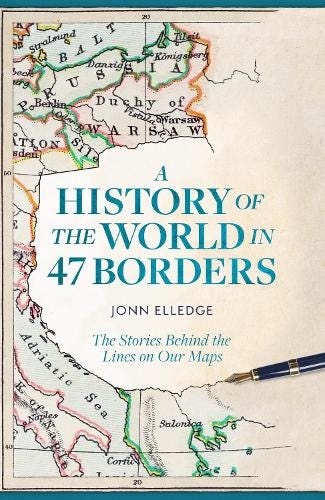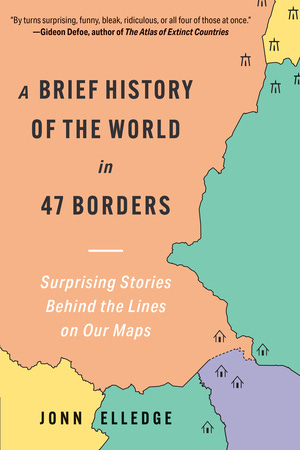That important question answered below. But first an important* announcement: Paper Cuts is doing its first live show two weeks today, at 3.30pm at the Clapham Grand. Miranda Sawyer will be hosting, with myself, Marcus Brigstocke, Coco Khan and my arch nemesis Gráinne Maguire as panellists. I have no idea what they’re going to do with us, I gather some kind of quiz involving the news.
Who among you hasn’t, at some point, secretly wanted to watch me humiliate myself in front of proper people? Come along! It’ll be fun! You can book your ticket here.
Right, that’s enough of that. This one went to paying subscribers back in July…
On election eve, when nobody was paying attention to such things, an episode of the Aspects of History podcast I’d recorded to promote A History of the World in 47 Borders some time before finally popped out into the world. One of the topics that came up in the closing moments of that show was one which is not really touched upon in the book. “Middlesex,” the host, Oliver Webb Carter, suggested, “doesn’t really exist, does it?”
Middlesex, if you’ve never had the pleasure, was the second smallest English county after Rutland, and the one from which London was carved.1 My home, in the East End, would once have been Middlesex. So would the cafe in Stoke Newington in which I am writing right now, and the offices of most of my employers, and really the entire centre, north and west of today’s Greater London.
Few of those places, though, would ever be described as Middlesex today. Which got me thinking: was Oliver right? Does Middlesex still in any meaningful sense exist?
Etymology first. The county’s name has the same origin as Essex, Wessex or Sussex: the “Middle Saxons”, a group of post-Roman arrivals from today’s Germany, who settled in between the eastern, western and southern groups of their peers. The word “Saxon”, incidentally, has its origin in the seax, a small sword or knife used by certain Germanic tribes: it’s the one you can still see three of on the arms of Essex and Middlesex alike.
The main difference between those two sets of arms is that the latter also includes a crown, added in 1910 to distinguish the two. And the reason those two counties had the same arms at all is that Middlesex, unlike the other Saxon territories listed above, never was a kingdom in its own right: instead it was a part of the East Saxon realm. (This, pleasingly, means London was once in Essex.) It’s not immediately obvious why it got a separate name: perhaps it was because Essex was a relatively weak kingdom, and Middlesex was sometimes attached to another; perhaps it’s because Essex ended up in the Danelaw, and Middlesex didn’t, solidifying a sense that they were different things. Ancient Middlesex does seem to have been bigger than the county it became, though, and probably included Hertfordshire, too.
At any rate: once the kings of Wessex had unified England and divided it into shires for ease of administration, probably sometime around the year 900, Middlesex ended up as a county in its own right. At that point, Middlesex definitely did exist: it contained all the land between the rivers Colne, Thames and Lea, with its northern border with Hertfordshire defined by a line of hills, and it was as real and solid as any other English county.
Quite early in its history, though, Middlesex began to fracture. Some time in the 12th century, the City of London became a self-governing “county corporate” – a sort of medieval unitary authority, treated in some ways like a county in its own right – and the sheriffs of London were given jurisdiction over the rest of the county, weakening its own self-government. Later, the Tower Division, covering most of today’s East End, became largely independent, with its own Lord Lieutenant (a man whose job was to represent the interests of the crown). It was more akin to one of the Ridings of Yorkshire, counties in all but name, than the “hundreds” which operated below most counties.2
So, administered from beyond its out borders, with local government taking place at parish or hundred rather than county level, Middlesex barely existed as a political unit; but it did still exist as a territorial one. Everything changed, though, with the local government reorganisation of 1889, when its most populous sixth was cut away and joined with bits of Surrey and Kent to form the new County of London. Middlesex definitely still existed – for the first time, it had a proper county council and everything – but as a strange, truncated thing.

And then, in 1965, everything changed again with the creation of Greater London, formed of the County of London, plus more Surrey, more Kent, a big chunk of Essex, and almost, but not quite, the entire rest of Middlesex. (There were some offcuts, which ended up in Hertfordshire and Surrey.3 Meanwhile, a tiny sliver of Hertfordshire, which had poked into Middlesex for some reason I’ve not been able to pin down, ended up in the London Borough of Barnet.)
Middlesex persisted for a while as a postal county – the bit you once wrote in addresses before a postcode – but it was divided into two bits with a six mile stretch of London and Hertfordshire between them, and postal counties were in any case abolished as unnecessary in 1996.

Today Middlesex is not a postal unit, nor a political one, nor, in any meaningful sense, a territorial one. And the suburbs that were once in Middlesex seem strikingly more comfortable with their status as outposts of London than those carved from Essex or Surrey or Kent. (How much of that is because they were part of the great lost county, and how much is just because they got most of the tube lines, I’m not sure.)
What’s left? Middlesex still has a cricket team. It’s a name attached to a couple of hospitals and other institutions. It’s also a useful label for one bank of the Thames, to get around the fact that, in places, the “north bank” actually isn’t. But in a very real sense, unlike most of England’s ancient counties, today there’s nothing there. Oliver was right: Middlesex doesn’t really exist.
There are those who’d have it otherwise, of course, such as the Association of British Counties, who seem determined to preserve things in aspic as they were around the time of the 1889 changes. (I’m being slightly vague here because its commitment to a map of counties including no counties corporate, no exclaves but also no County of London was not, best I can tell, a situation that ever actually existed.) Nonetheless, territorial units not backed up by other forms of identity can and do die. No one would seriously consider Elmet or the Soke of Peterborough to still be going concerns; no one would say they come from Neustria, rather than the provinces or departments that replaced it. Is Middlesex really any different?
To conclude, a story and a quote. Story first: Middlesex Day, you’ll be pleased to hear, is celebrated each year on 16 May, to commemorate the 1811 Battle of Albuera, a part of the Peninsular War. That saw the 57th (West Middlesex) Regiment hold out under intense pressure from the French, while their injured commanding officer shouted the confusing encouragement, “Die hard, 57th, die hard!” They won. The 1988 Christmas movie Die Hard is not about them.
The quote comes from Sir John Betjemen, the chronicler of Metroland and a Middlesex Man through and through. In his 1968 poem, Contrasts: Marble Arch to Edgware – A Lament, the poet wrote:
Dear Middlesex, dear vanished country friend,
Your neighbour, London, killed you in the end.
He wasn’t wrong.
Paying subscribers get more things, much earlier. If you can’t afford to pay then just hit reply and you can have a freebie (really, it’s not a trick). But if you can, here’s a convenient button to help with that:
And if you enjoyed all that, you might also enjoy my book:
Available in North American in less than two weeks!
This is already contentious, at least twice. Bristol, which spanned the River Avon to include parts of Gloucestershire and Somerset, has effectively had county status since the Middle Ages; so, as we’ll see, has the City of London, even though that was constrained to one bank of the Thames.
There was also sometimes, it’s worth noting in passing, an Earl of Middlesex. But this was just a title, and peerages can be named for bits of land without actually having any real connection to them. See also the Dukes of Edinburgh, Cambridge and Sussex, Countess of Wessex, Prince of Wales, etc.
There’s also a single village, Poyle, that ended up in Slough, which makes it a part of Berkshire, in a borough that was once part of Buckinghamshire. I don’t expect you to know what to do with this information any more than I do, but if I don’t write it down I will start twitching uncontrollably.




